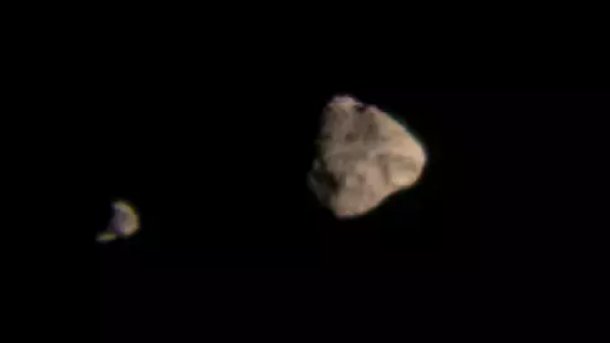Trip by NASA's Lucy probe: mini moon of asteroid Dinkinesh is very young
When NASA's Lucy probe passed the Dinkinesh asteroid, nobody was prepared for the surprises it had in store. Now there is another one.

Dinkinesh mit Selam (links)
(Bild: NASA/Goddard/SwRI)
The mini-moon of the asteroid Dinkinesh, which was only discovered after the flyby of NASA's Lucy probe, is just two to three million years old and therefore a "baby asteroid" in the cosmic sense. This is the result of calculations based on the orbit of the bipartite mini-moon called Selam, as Cornell University has now published. The method used has several advantages, the research team explains. Not least, it also works without close-up images of the celestial bodies and promises results when their surfaces have changed significantly. The mini-moon Selam is therefore even younger than the pre-human skeleton, after which the probe that discovered it is named.
Surprisingly productive detour
Colby Merrill's team began the model calculations immediately after the discovery. As the group explains, binary systems such as that of Dinkinesh and Selam are highly complex: while the effects of gravity ensure that such systems gradually lose energy, radiation from the sun also has an influence on them. At some point, an equilibrium is reached. Based on these assumptions and using the data on the orbits of the celestial bodies, the group has carried out a million simulations on the history of the system. These have yielded ages of between one and ten million years, with two million as the most likely value. The study presented in Astronomy & Astrophysics confirms that such systems continue to form.
Lucy flew past Dinkinesh on November 1 at a distance of about 400 km and at a speed of about 16,000 km/h. It was only a test. It was simply a test to see if the probe's scientific instruments were working. Surprisingly, the asteroid proved to be extremely exciting. It was not previously known that the asteroid had a moon, which turned out to be split in two. In astronomy, this is known as a "contact binary". The mini-moon of Dinkinesh, later named Selam, is the first satellite of an asteroid with this shape.
NASA's Lucy probe is named after a more than three-million-year-old fossil of the human ancestor Australopithecus afarensis and has been on its 12-year mission since October 2021. On this mission, it will visit and explore several asteroids that precede or follow Jupiter on the same orbit around the sun – the Jupiter Trojans. These primitive celestial bodies are considered fossils of planet formation. When it started its journey in 2021, only flybys of seven asteroids were planned, but then satellites were discovered on two of them and the originally unplanned detour to Dinkinesh was included. Since then, it has been the smallest asteroid in the main belt between Mars and Jupiter to be visited by a probe.
(mho)